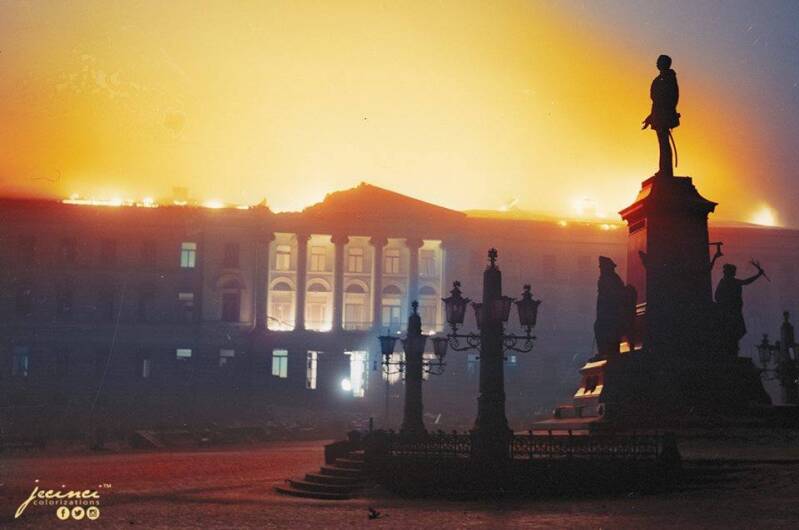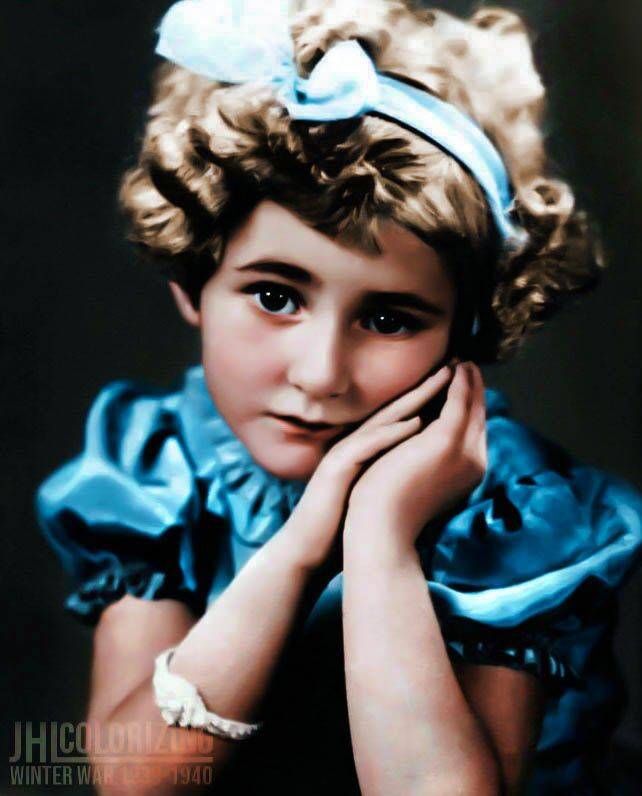The Soviets arrive
The sound of the civil defence siren at 09:20 and the subsequent rumble of aircraft engines were their first clues that something was wrong. Many Helsinki residents watched in awe as the low-flying Soviet aircraft shot overhead, but instead of dropping bombs, its bomb bays released scraps of paper.
In order to free themselves from oppression and topple the Imperialist Government, these pamphlets told the people of Finland. that they wouldn't have to live in labour camps or go hungry.
The shocked citizens of the nation's capital laughed at these propaganda pieces, but they soon realised that Helsinki was about to experience its darkest hour.
The Soviet 35th Rapid Bomber Regiment launched a flight of six SB-2 bombers from an airstrip in Siverskaya. It was instructed to attack the Helsinki train station before moving on to the Malmi airport. As the aircraft neared Finland, the clouds were exceedingly dense, and finally one section of the flight decided to abandon their attack and return to Severskaya. There were now only 3 machines left, so Captain Saranchev continued with his task. Only 400 metres above the Töölö neighbourhood, they broke through the clouds, and almost immediately began dropping their payload of flyers urging the populace to rebel against their terrible overlords.
The Soviet bombing of Helsinki on November 30, 1939
The main building of Helsinki University, on Senate Square, burns during the night.
Jecinci Colorizations
Captain Saranchev dropped a few bombs that were aimed at the train station as they flew over Helsinki, but they missed and, fortunately for the Finns, only slightly damaged the city centre. The aircraft carried on to Malmi Airport, where the bombers released their remaining payloads, which killed three people and injured an additional nine.
Before shortly, the following wave showed up. At little after 1030, a squadron of the 57th Mixed Aviation Regiment of the Red Banner Baltic Fleet, commanded by Major V.I. Rakova, flew over the military installation in Santahamina. The hydro airport at Santahamina was to be destroyed. At a distance of 400 metres, the 10-aircraft unit launched its attack over the military complex, hitting a number of barracks and the hangar.
Finnish anti-aircraft crew in action in Helsinki.
SA-kuva
The mission was successful, although several seaplanes could not be recovered, the hanger was nearly destroyed, and numerous other military buildings suffered damage. Seven men were wounded, some of them critically, according to the combat diary. But where were the defences of the base? The designated heavy anti-aircraft battery didn't start firing until the final bombers released their payloads, shaking some of them but not all of them.
After the morning's excitement, Helsinki residents were in a state of shock. Many citizens were left in a fog. Some grabbed brooms and tried to clean up the damage, while others started packing to leave the city. But it was on this day that Helsinki became the target of the Winter war's deadliest raid. Just after midday, eight DE-3 bombers from the Red Banner Baltic Fleet's 3rd Squadron, 1st Mine-Torpedo Air Regiment, took out from Klopitsa with the mission of destroying the Hanko-area coastal defence ships Väinämöinen and Ilmarinen.
Damage caused by the Russian bombing of Helsinki.
Julius Jääskeläinen
Major N. J. Tokarev gave the order for the squadron to regroup when the squadron reached off the coast of Hanko and made an effort to find the vessels. If the ships couldn't be found, he was to aim for Helsinki's harbour facilities, according to his orders. However, because of a combination of bad weather and a lack of recognisable landmarks, the planes lost their bearings and were no longer in formation as they broke through the clouds over Helsinki. The lead aircraft almost instantly discharged its payload, and the remainder of the formation quickly followed. The majority of the bombs splashed harmlessly into the water off Hietalahti.
The ensuing path of devastation cut through the centre of the city. The bus station in Kamppi was severely damaged, a Lutheran Church was destroyed, and much to the delight of the locals, the Soviet Embassy was also damaged.
The Helsinki University of Technology was also all but destroyed. It took two days to put out a fire at an oil storage facility in Hietalahti. A flight of four fighters was scrambled from Malmi but was unable to catch up to the retreating bomber formation as the city's strong AA guns hammered away at the aircraft but failed to score any damage. The attack resulted in 91 deaths and 240 injuries.
International reaction
International journalists flooded Finland as tensions between Finland and the Soviet Union grew and the Anglo-French alliance did nothing to stop Nazi Germany.
One of the great war correspondents, Martha Gellhorn, arrived in Helsinki's Hotel Kamp on November 29, completely unaware that the city would be bombed the following day. She was exhausted after travelling nearly 4,000 miles, crossing the Atlantic, flying over the North Sea, and stopping in neutral Sweden before continuing on to Helsinki.
She spent several hours in the hotel bar gathering "intelligence" from the roughly a dozen other correspondents present before retiring for the evening.
The following morning, as she awoke to the sounds of bombs detonating, she picked up several of the flyers that the aircraft had scattered over the city as she made her way outdoors. Gellhorn was in the middle of having a quick lunch when the last attack arrived. " I never felt such explosions. The whole place rocked”. In a letter to her boyfriend, Ernest Hemingway, she said, "Must have been like March in Barcelona”.
She and two Italian journalists went outside to assess the damage when the all-clear was given. The veteran journalist eventually became overwhelmed by the sight of burning homes, destroyed stores, and broken lives, and she turned on her escort by reminding them of the deeds of the Germans and Italians which she had witnessed first-hand during the Spanish Civil War.
A row of damaged shops highlights the damage caused by the bombers.
In the Kamp's press room, another reporter, Herbert Elliston of the Christian Science Monitor, was feverishly calling people to either receive or provide information. He was a former Royal Horse Artillery trooper and was unfazed by the destruction. "This was a Blitzkrieg designed to overcome and conquer the Finns from the air," he later wrote. "I watched intently, because victory or defeat in this type of diplomacy-war depend upon the behavior of the panic.”
What he also recorded though was something that would be more notable than just the bombings, “All this time noise continued without cease – the dull detonation of exploding bombs breaking through a continual screech of air raid alarms and the rat-tat-tat of machine gun.” Many others that day recorded the streets being machine-gunned. According to the Finnish military HQ's official press release “Enemy pilots shot civilians with machine-gun fire.” and this was reprinted across many papers worldwide.

The aftermath of the Soviet bombers attack on the Finnish capital, Helsinki.
Fox Photos/Getty Images
It didn't take long for rallies to be organised by people all over the world outside Soviet Union embassies or in the capitals calling for action. There was a League of Nations emergency session, and several of the delegates openly denounced the Soviet Union's activities. Soon after, the Soviet Union's foreign minister, Vyacheslav Molotov, made a radio broadcast in which he claimed that instead of bombing Finland or killing its starving population, the Soviet Union was instead dropping bread for them.
Reaction of the population
Harry Matso, 15, was given the task of helping his instructors transport the remainder of his school to safety at the Hietaniemi graveyard. All the pupils and teachers ducked under gravestones and sought cover against the high stone walls of the cemetery as the planes roared overhead. They kept still as the street in front of them caught on fire, and the teenager was relieved to learn that all of his classmates and teachers were unharmed when the all-clear signal was given.
Unfortunately, an apartment next to the cemetery was hit, and Harry subsequently remembered seeing a grieving man come out of the destroyed structure holding his daughter's lifeless body.
The most well-known fatality on that day, however, was Armi Metsäpelto, who was being driven by her mother to the bus station when she was killed. The family decided that it would be safer for their daughter to stay with relatives in Lapland following the morning raids.
They were caught up in the second raid, and one of the bombs that fell close to the bus terminal killed Armi. She would later become a symbol for the suffering of the civilian population in Finland.
The return of Mannerheim
Despite all the destruction and suffering, one of Helsinki's most prominent residents benefited from the bombings. A veteran soldier's meal was disturbed when the bombs first dropped on Helsinki. He got up from the table right away, put on his uniform, and made his way to the Ministry of Defence. One of Finland's founding fathers, 72-year-old Carl Gustaf Mannerheim, had recently resigned from his seat on the defence council and was planning his retirement. He was a man, nonetheless, who was determined to serve his country as he walked unimpeded into the office of Defence Minister Juho Niukkanen.
Without engaging in debate, he informed the defence minister that he is taking over as commander-in-chief. Niukkanen then informed the retired Marshal of the information he had learned. Posters, newspapers, and radios all over the country were announcing by day's end that Mannerheim was now in control of Finland's defence. "I can vouch for the fact that no proclamation ever geared a nation into fighting mood more successfully than the proclamation making Mannerheim commander-in-chief," Ellison said in reference to how rapidly this news circulated across the populace of the shattered city.
Other bombings
The explosions that hit Helsinki on the first day were the deadliest to hit the city throughout the war, but they were regrettably not the last. The city was already bombed on December 1st, although the impact was not as great as the overnight surprise raids. The city will have two additional bombings on 9th December and 25th December; two other bombings on 13th and 14th January; and one final bombing on 2nd February.
96 people were killed, 38 were critically injured, and 236 more were wounded across the city as a whole. Nevertheless, despite being in a state of war, the city continued to run. In less populated regions of the nation, many non-essential residents were relocated.
Within weeks, Helsinki's population of about 250,000 had dropped to about 65,000. The Red Air Force bombed Helsinki in an effort to remove the head of the Finnish state, but the overall damage to the city was largely cosmetic due to bad weather and the aircrew's subpar performance.
Further reading
Sources:
Wikipedia
https://www.finlandatwar.com/the-bombings-of-helsinki/
https://slon-76.livejournal.com/9172.html
https://forum.axishistory.com/viewtopic.php?f=59&t=189113&p=1700412&hilit=helsinki+bombing#p1700412
Sander, Gordon F. The Hundred Day Winter War: Finland’s Gallant Stand against the Soviet Army. (University Press of Kansas, 2013)
Jecinci Colorizations
Julius Jääskeläinen
Fox Photos/Getty Images
SA-kuva
Finland in World War II - The Atlantic
JH Colorizing






